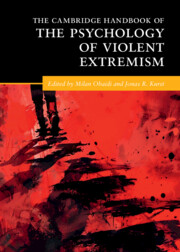Book contents
- The Cambridge Handbook of the Psychology of Violent Extremism
- The Cambridge Handbook of the Psychology of Violent Extremism
- Copyright page
- Dedication
- Contents
- Figures
- Tables
- Contributors
- 1 Introduction
- Part I Concepts, Definitions, and Trends
- Part II Individual-Level Perspectives
- 4 Individual Differences and Violent Extremism: Personality, Mental Disorders, and Risk Pathways
- 5 Conceptualizing Diversity among Violent Extremists
- 6 The Role of Gender in Violent Extremism
- 7 Quest for Significance and Violent Extremism
- 8 Religious Fundamentalism and Violent Extremism
- 9 Conspiracy Theories and Violent Extremism
- 10 Violent Extremism and the Moral Landscape
- 11 Emotions in Violent Extremism
- Part III Group-Level Perspectives
- Part IV Macro-Level Perspectives
- Index
- References
7 - Quest for Significance and Violent Extremism
from Part II - Individual-Level Perspectives
Published online by Cambridge University Press: 31 October 2025
- The Cambridge Handbook of the Psychology of Violent Extremism
- The Cambridge Handbook of the Psychology of Violent Extremism
- Copyright page
- Dedication
- Contents
- Figures
- Tables
- Contributors
- 1 Introduction
- Part I Concepts, Definitions, and Trends
- Part II Individual-Level Perspectives
- 4 Individual Differences and Violent Extremism: Personality, Mental Disorders, and Risk Pathways
- 5 Conceptualizing Diversity among Violent Extremists
- 6 The Role of Gender in Violent Extremism
- 7 Quest for Significance and Violent Extremism
- 8 Religious Fundamentalism and Violent Extremism
- 9 Conspiracy Theories and Violent Extremism
- 10 Violent Extremism and the Moral Landscape
- 11 Emotions in Violent Extremism
- Part III Group-Level Perspectives
- Part IV Macro-Level Perspectives
- Index
- References
Summary
In this chapter, we discuss the psychological foundations of violent extremism. We consider violent extremism as a specific form of extreme behavior resulting from a radicalization process that involves inflicting a high-severity aggression or violence against people or properties as a means to achieve a political, ideological, or religious goal. Throughout our discussion, we focus on the role of the need for significance (Kruglanski et al., 2022) as a core psychological driver that prompts violent extremism. We review those factors that activate the need for significance, propelling individuals toward violent extremism. Specifically, we posit that when the quest for significance is activated, whether by personal or group-level experiences of significance loss or opportunities for gain, individuals seek avenues to fulfill this need through extreme actions that demonstrate their allegiance to socially esteemed values. In such scenarios, violent extremism emerges as a viable outlet, especially when bolstered by a narrative that promotes it and a supportive social network that endorses the narrative, offering validation and significance to individuals who express their commitment through their actions. Finally, we outline how the theoretical framework centered on the need for significance can inform the development and implementation of deradicalization programs by practitioners.
Keywords
Information
- Type
- Chapter
- Information
- The Cambridge Handbook of the Psychology of Violent Extremism , pp. 119 - 141Publisher: Cambridge University PressPrint publication year: 2025
